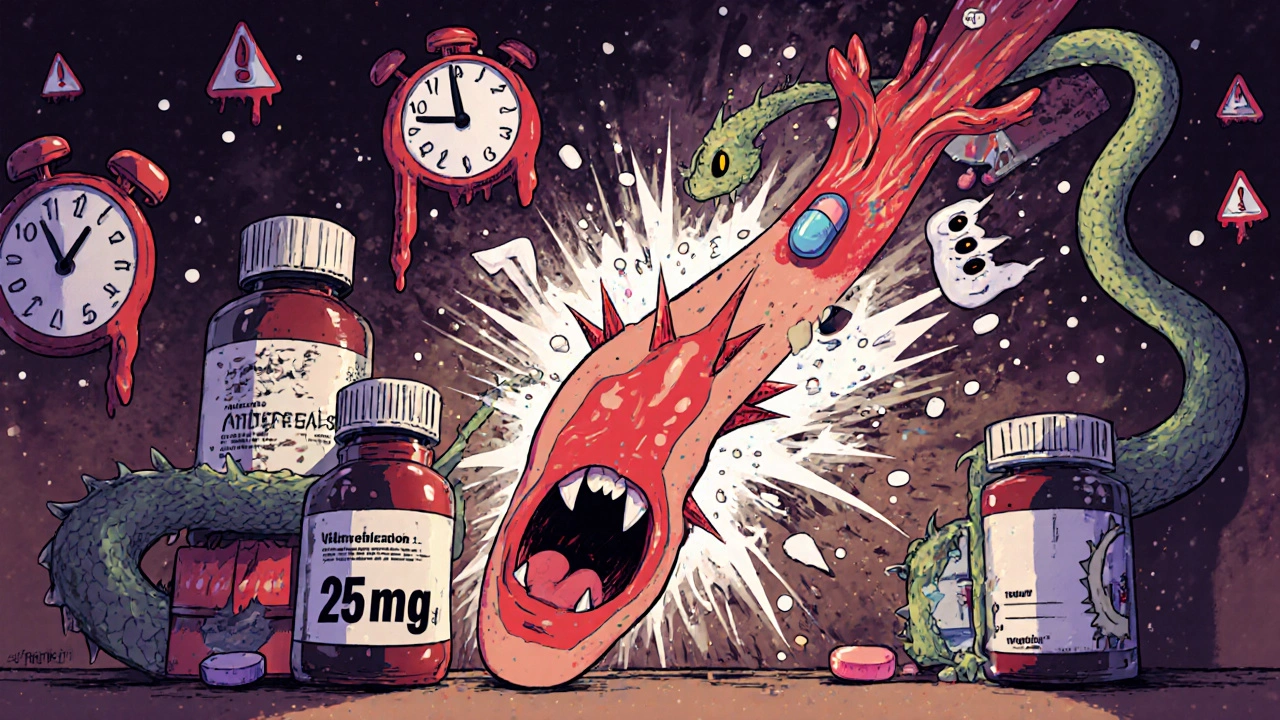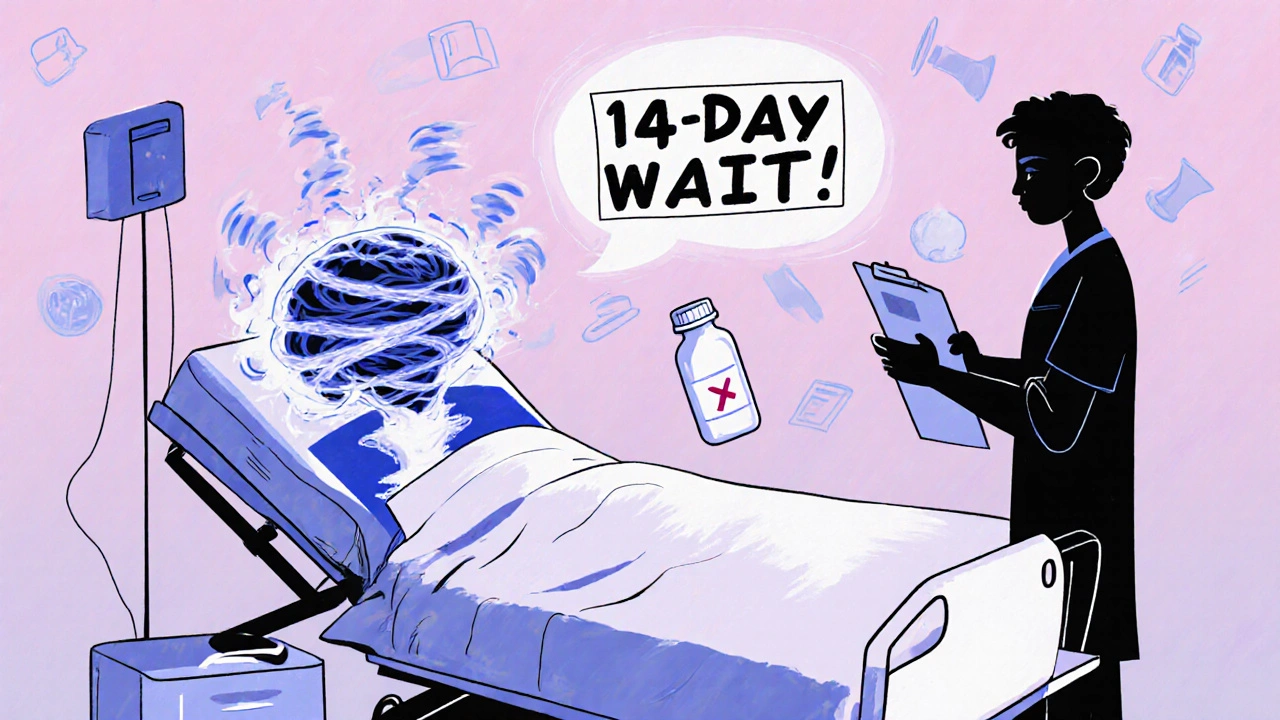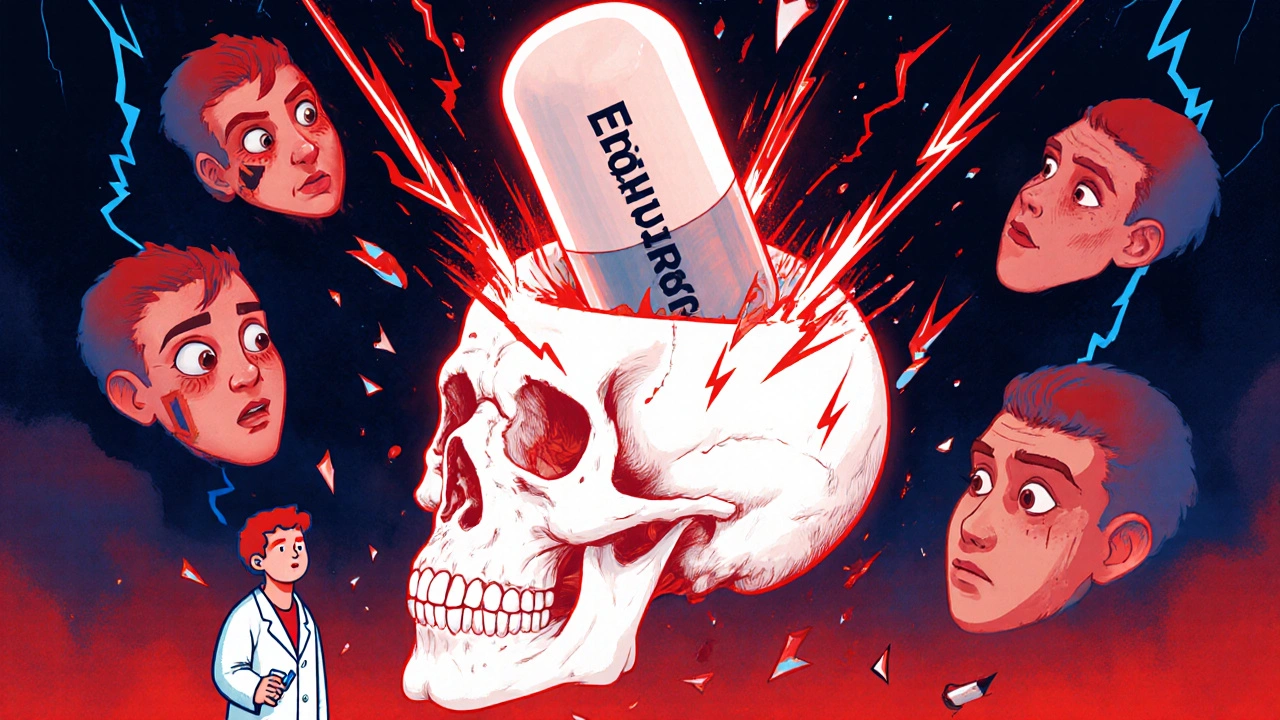MAOI Medication Checker
This tool checks if over-the-counter medications contain ingredients dangerous when combined with MAOI antidepressants. Ephedrine and similar compounds can cause life-threatening blood pressure spikes.
Enter a medication name to check if it's safe with MAOIs.
Important Information
Ingredients to avoid with MAOIs: Ephedrine, pseudoephedrine, phenylephrine, phenylpropanolamine
Even small doses can trigger hypertensive crisis. One pill is all it takes. Always consult your psychiatrist before taking any new medication.
One oral pill. That’s all it takes. A simple cold medicine with ephedrine, taken by someone on an MAOI antidepressant, can trigger a blood pressure spike so violent it bursts blood vessels in the brain. This isn’t a rare accident. It’s a well-known, preventable killer - and it still happens today.
What Happens When Ephedrine Meets an MAOI?
Ephedrine is a stimulant. It’s found in some over-the-counter decongestants, weight loss pills, and energy supplements. It works by forcing your body to release norepinephrine - a chemical that tightens blood vessels and raises your heart rate. That’s why it clears nasal passages and gives you a jolt of energy.
MAOIs - monoamine oxidase inhibitors - are antidepressants like phenelzine (Nardil), tranylcypromine (Parnate), and isocarboxazid (Marplan). They work by blocking an enzyme called monoamine oxidase. Normally, this enzyme breaks down excess norepinephrine, serotonin, and dopamine. When it’s shut down, those chemicals build up.
Now put them together. Ephedrine floods your system with norepinephrine. The MAOI stops your body from clearing it. The result? A runaway surge of norepinephrine. Blood pressure doesn’t just rise - it explodes. Systolic pressure can hit 240 mmHg in under an hour. That’s higher than most race cars’ tire pressure.
The Symptoms Are Impossible to Ignore
This isn’t a mild headache or a racing heart. This is a medical emergency. Symptoms come fast:
- Severe, pounding headache - often starting at the back of the skull and shooting forward
- Blurred vision or seeing white spots
- Chest tightness or crushing pain
- Profuse sweating, even in a cool room
- Nausea, vomiting, or feeling like you’re going to pass out
- Palpitations so strong you can feel them in your throat
- Neck stiffness or sensitivity to light
Some people describe it as ‘my head is going to explode.’ That’s not dramatic. That’s accurate. In documented cases, patients have suffered subarachnoid hemorrhages - bleeding in the space around the brain - within 30 minutes of taking ephedrine.
It’s Not Just Prescription MAOIs
Many people think this only matters if they’re on a strong antidepressant. But here’s the catch: ephedrine is in dozens of OTC products. You don’t need a prescription to buy it.
Check the label of any cold, flu, or sinus medication. Look for these ingredients:
- Ephedrine
- Pseudoephedrine
- Phenylephrine
- Phenylpropanolamine (banned in the U.S. but still found overseas)
Even a single 25 mg dose - the standard amount in a cold tablet - can trigger a crisis. That’s half the dose of some weight-loss pills. You don’t have to be taking a lot. One pill. One time. That’s all it takes.
The Risk Doesn’t Disappear When You Stop the MAOI
People often think: ‘I stopped my MAOI last week. I’m safe now.’ That’s dangerously wrong.
Irreversible MAOIs like Nardil and Parnate permanently disable the monoamine oxidase enzyme. Your body doesn’t just ‘reset’ after you stop taking them. It takes two to three weeks for your liver to grow new enzyme molecules. Until then, you’re still at risk.
Even newer MAOIs like the selegiline patch (Emsam) carry risk - though lower. And reversible MAOIs like moclobemide are safer, but still dangerous with ephedrine. There’s no safe gray zone.

Real Cases. Real Deaths.
In 1965, a 49-year-old woman took one 25 mg ephedrine tablet while on nialamide (an MAOI). Within 30 minutes, she lost consciousness. A CT scan showed bleeding in her brain. She died hours later.
In 2018, a 32-year-old man on phenelzine took a cold tablet with ephedrine. His blood pressure hit 240 mmHg. He suffered an intracranial hemorrhage. He survived, but with permanent brain damage.
Between 2015 and 2020, the FDA recorded 37 cases of hypertensive crisis from this interaction. Nine of them were fatal. Reddit threads from people on MAOIs are filled with stories: ‘I thought it was just a bad headache. Then my vision went white. I called 911.’ ‘My husband took Sudafed and ended up in the ICU.’ ‘I almost died and didn’t even know why.’
Doctors Still Miss This
Here’s the scary part: this isn’t just patient error. It’s a systemic failure.
A 2021 study in JAMA Internal Medicine found that 22% of patients prescribed MAOIs were given at least one contraindicated medication within 30 days. Often, it was a primary care doctor, a pharmacist, or an urgent care provider who didn’t know the risk.
MAOIs are rare now - less than 1% of antidepressant prescriptions. That makes them easy to overlook. But for people with treatment-resistant depression, they’re often the only option that works. And when they’re prescribed, the safety protocols need to be ironclad.
What to Do If You’re on an MAOI
There’s only one rule: Never take ephedrine or any decongestant unless your psychiatrist explicitly says it’s safe.
Here’s what you need to do:
- Get a printed list of all contraindicated medications from your prescriber. Keep it in your wallet.
- Carry an ‘MAOI Alert Card’ - like the ones recommended by Mayo Clinic. It says: ‘I am on a monoamine oxidase inhibitor. Do not give me decongestants, stimulants, or certain painkillers.’
- Before taking ANY new medication - even herbal supplements - check with your psychiatrist or pharmacist. Don’t assume it’s safe.
- Wait at least 14 days after stopping an irreversible MAOI before using any sympathomimetic drug.
- Tell every doctor, dentist, and emergency responder you see that you’re on an MAOI.

What to Do in an Emergency
If someone on an MAOI develops sudden, severe headache, chest pain, or high blood pressure after taking a cold medicine:
- Call 911 immediately.
- Do NOT give them sublingual nifedipine. It’s sometimes used for high blood pressure, but it can cause a dangerous drop in pressure and trigger a stroke.
- Only trained medical staff should administer treatment - typically intravenous phentolamine, which blocks the excess norepinephrine.
Time is brain. Minutes matter.
The Future: Safer Options?
There’s hope. In March 2023, the FDA approved a new reversible MAOI called befloxatone. Early studies show it has a 90% lower risk of hypertensive crisis because it breaks down in just six hours. It’s not yet widely available, but it’s a sign that safer options are coming.
Researchers are also testing wearable blood pressure patches that can detect early spikes in people on MAOIs. If it works, it could give a warning before a crisis hits.
But until then, the rule hasn’t changed: ephedrine and MAOIs don’t mix. Not ever.
Why This Still Matters
MAOIs aren’t going away. They’re the most effective treatment for some forms of depression - especially atypical depression, where people feel heavy, tired, and oversensitive to rejection. For those patients, MAOIs can be life-changing.
But they’re also dangerous if used carelessly. The same pill that helps someone breathe again can kill them if they take it with the wrong cold medicine.
This isn’t about fear. It’s about awareness. It’s about making sure the next person who reaches for a decongestant knows exactly what’s at stake. One question. One check. One conversation with a doctor. That’s all it takes to prevent a tragedy.
Can I take pseudoephedrine if I’m on an MAOI?
No. Pseudoephedrine is just as dangerous as ephedrine when combined with MAOIs. It works the same way - forcing norepinephrine release. Even small doses can trigger a hypertensive crisis. Avoid all decongestants containing pseudoephedrine, phenylephrine, or phenylpropanolamine. Use saline sprays or humidifiers instead.
How long after stopping an MAOI is it safe to take ephedrine?
For irreversible MAOIs like Nardil or Parnate, wait at least 14 days. For best safety, wait 21 days. For reversible MAOIs like moclobemide, 24 to 48 hours is usually enough. But never assume - always check with your psychiatrist. The enzyme regeneration timeline varies by person, and there’s no margin for error.
Are all MAOIs equally dangerous with ephedrine?
No, but the difference isn’t enough to risk it. Irreversible MAOIs (phenelzine, tranylcypromine) are the most dangerous because they permanently disable the enzyme. Reversible ones like moclobemide are less risky, but still dangerous. Even the selegiline patch (Emsam) carries a warning. There is no safe MAOI-ephedrine combination. Avoid them all.
Can I use ephedrine if I’m not on an MAOI but took one recently?
If you stopped an irreversible MAOI less than 14 days ago, you’re still at high risk. The enzyme hasn’t regenerated yet. Even if you feel fine, your body is still vulnerable. Wait the full 14-21 days. If you’re unsure, get a blood test or consult a pharmacist who specializes in psychiatric meds.
What if I accidentally took ephedrine while on an MAOI?
If you’ve taken ephedrine and are on an MAOI, monitor yourself closely for the next 2 hours. If you develop headache, chest pain, vision changes, or rapid heartbeat - call 911 immediately. Do not wait. Do not take aspirin or other painkillers. Emergency treatment requires specific drugs like phentolamine, which only hospitals can give. Time is critical.
Are there safe alternatives to ephedrine for congestion?
Yes. Saline nasal sprays, humidifiers, steam inhalation, and antihistamines like loratadine or cetirizine are safe. Avoid any product labeled ‘decongestant,’ ‘sinus relief,’ or ‘cold and flu’ unless your psychiatrist has approved it. Always read the active ingredients - many OTC products hide stimulants under vague names.


Rachael Gallagher
They let this stuff sit on shelves like candy. One pill. That’s it. People die because Big Pharma doesn’t care if you live or die as long as you buy the box.
steven patiño palacio
This is one of the most important public health warnings I’ve read in years. The fact that this interaction is still causing deaths in 2025 is unacceptable. Every pharmacy should have a mandatory warning sticker on any product containing pseudoephedrine or phenylephrine. No exceptions.
stephanie Hill
Did you know the FDA knew about this since the 80s? They buried it. Same people who pushed opioids. Same people who approved vaping. They want you sick. They want you dependent. They want you on meds forever. It’s not an accident - it’s business.
Akash Chopda
They sell ephedrine in India too. No warning. No label. People die daily. No one cares. Pharma is global scam
Nikki C
I’ve been on moclobemide for three years. I used to think saline sprays were overkill. Now I carry a card in my wallet. One conversation with my pharmacist saved my life. Don’t wait until it’s too late.
Alex Dubrovin
Just got prescribed phenelzine last week. Read this post and immediately deleted every cold med in my cabinet. Holy shit. I’m not taking chances. This is real. I’m telling everyone I know.
Natashia Luu
It is profoundly disturbing that physicians continue to prescribe MAOIs without ensuring patients are fully educated on the risks. This is not negligence. This is malpractice. The standard of care has been violated. Again.
akhilesh jha
I’ve seen a patient in ICU after taking Sudafed. He didn’t even know he was on an MAOI - his psychiatrist had switched him weeks before and never told him the danger lasted longer than the drug. He’s paralyzed now. It’s not a story. It’s a warning.
Jeff Hicken
why do people even take these drugs anyway? like why not just try therapy or something? also i took a cold pill once and i was fine so maybe its just fake news?
Vineeta Puri
To those newly prescribed MAOIs: Please, take a moment to print the list of contraindicated medications. Keep it with your ID. Share it with your family. This knowledge is not optional - it is your lifeline. You are not alone in this journey.
Victoria Stanley
I’m a pharmacist. I’ve had patients come in asking if they can take NyQuil while on Nardil. I’ve had to say no 47 times this year. I keep a laminated card on my counter: ‘MAOI Alert - Do Not Dispense Decongestants.’ It’s not enough. We need better systems.
Andy Louis-Charles
Just shared this with my entire family. 🚨 If you’re on an MAOI or know someone who is - save this post. Print it. Put it on the fridge. This isn’t fearmongering - it’s survival. 🙏
Douglas cardoza
so like… can i take benadryl? i dont wanna die but i also dont wanna be congested
Adam Hainsfurther
My sister died from this in 2019. She took a cold tablet after stopping her MAOI - thought two weeks was enough. The ER didn’t know what was happening. She coded in front of me. I still wake up wondering if I could’ve done more. Please - don’t let this be your story.
Jacob McConaghy
Thank you for writing this. I’ve been on Emsam for two years and thought I was safe because it’s a patch. Turns out I wasn’t. I’ve since switched to a different med - not because I wanted to, but because I refused to risk my life over a decongestant. This post? It’s a gift.